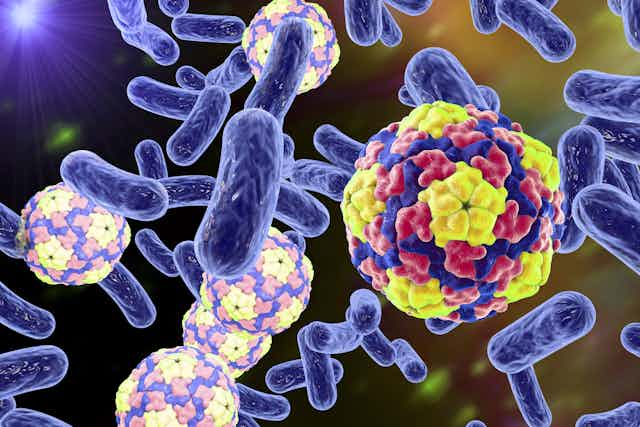When a virus infects a living cell, it hijacks and reprograms the cell to turn it into a virus-producing factory. Now scientists at the University of California have for the first time discovered just how extensive that reprogramming can be, effectively turning bacterial cells into animal or plant-like cells. This might even be how the cells of more complex organisms evolved in the first place.
The study shows that when a virus hijacks a bacterial cell, it quickly destroys the cell’s normal structure, including its DNA. It then builds new structures that strongly resemble the nuclei found in animal, human and plant cells. The nucleus is the genetic control centre of a cell of such a “higher” lifeform but has never been seen before in a bacterial cell. This suggests that higher cells might have first evolved from ancient interactions between bacteria and viruses.
We know that viruses work by inserting their genetic material into a host cell, which the viral DNA uses to replicate itself. Eventually the cell bursts open to release the new, intact viruses that can then infect other cells and begin the process again.
Writing in Science, the California research team described how they labelled viral proteins with fluorescent markers. They were then able to use a type of video microscope to see in real-time exactly what happened inside their bacterial host cell as the viral infection progressed.

They discovered that the different viral proteins assembled inside the bacterial cell into functional machinery that looked and behaved a lot like the nucleus of a human cell. This nucleus-like structure was positioned at the centre of the cell by long, tube-like protein fibres, just like the proteins responsible for positioning a human-cell nucleus.
Outside the nucleus-like structure, viral proteins were being built into viral shells. These give viruses their unique shape and serve as a means of protecting and transmitting viral DNA. Once the shells were complete, they were transported to the nucleus-like structure where viral DNA was packaged into them, ready to be released as new viruses.
Complex cell origins
Despite extensive research on viral replication, this is the first evidence that viruses reprogram bacterial cells to behave more like human or animal cells. The similarities between viral replication and complex cell processes could explain how higher lifeforms might have first evolved from early relationships between much simpler organisms, such as bacteria and viruses.
In particular, it supports a theory known as “viral eukaryogenesis”. This states that higher cells emerged when viruses took over bacterial cells and evolved to form a nucleus. This is similar to other theories that suggest mitochondria, the energy-generating “power-houses” of human and animal cells, were once free-living bacteria that existed inside early animal-like cells. Or that chloroplasts, which help plants convert sunlight into energy, were once free-living photosynthetic bacteria that evolved to be part of modern plant cells.
The results of this study could be pivotal for understanding how life evolved from relatively simple organisms into the complex and diverse life-forms that inhabit our planet today. In fact, this research redefines the long-held distinction between bacteria and higher organisms.
Also, viruses don’t just infect bacteria. Viral infections are extremely common in humans and animals, for example flu. It is possible that in future this detailed knowledge of viral replication in bacteria could be applied to the study of human and animal viral diseases.

